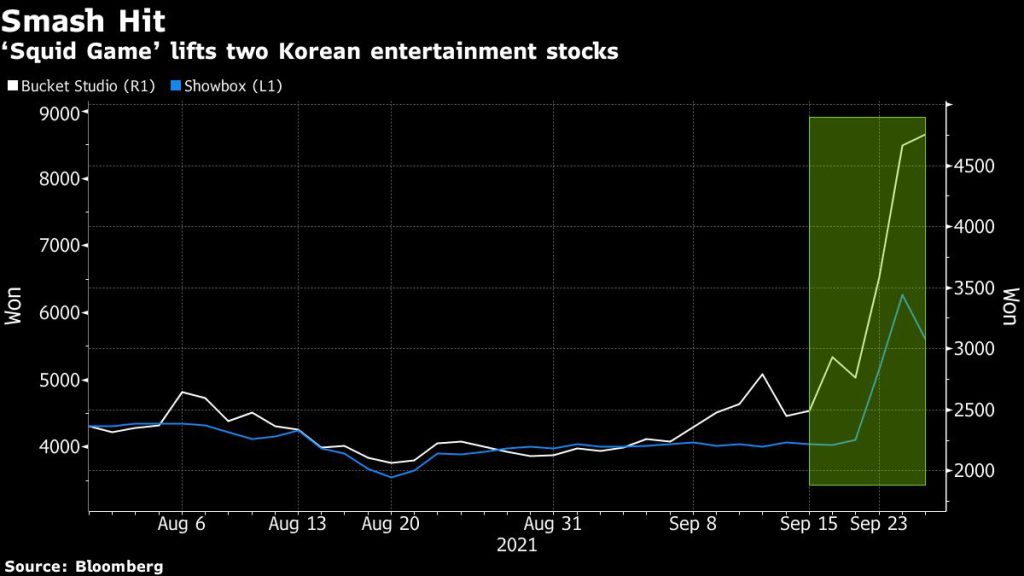The Squid Game connection and soaring markets

(that’s roughly over ₹286 crores!)
The Squid Game first aired on the 17th of September and has been making regular headlines since. A beautifully scripted critique of late-stage capitalism, it is the first Korean drama to rank No. 1 on Netflix in the US. Now, Netflix isn’t the only one lapping up profits from this show. The show’s success has caused the stocks of some famous South Korean media houses to rocket – two in particular.
The first is Bucket Studio Co., which owns a 15% stake in Artist Company, lead actor Lee Jung-Jae’s agency. According to The Korea Herald, bucket Studio Co has since doubled its market cap to ₩200 billion. The price has surged more than 70% in the past three trading sessions.
The second one is a film production and distribution company called Showbox. According to Bloomberg, it saw a jump of more than 50% from the 23rd of September to the 24th. Showbox had previously worked with Squid Game’s production company Siren Pictures, although it has no involvement in the TV series.
Korean content has taken the world by storm, and it’s been reflecting on the markets. According to analyst Douglas Kim, Korean movie and TV production stocks could outperform over the next 2-3 years on global demand for the nation’s entertainment content.

Markets Update
|
|
|
|
“There’s no stopping” is perhaps the first thing that comes to mind when talking about the equity markets these days. The Indian benchmark indices ended the week within touching distance from the all-time highs. We continued to see sectoral rotation play out with Nifty IT and Nifty Auto heavy-lifting for this week.
If anything was down significantly, that was India VIX. India VIX is an index that measures the volatility in the Indian markets, and for the week gone by, it was down more than 9%.
The landscape of institutional buying was a mixed bag. On the one hand, Foreign Institutional Investors (FIIs) were net sellers in the cash market to the tune of ₹3685 crores. On the other hand, Domestic Institutional Investors (DIIs) were net buyers in the cash market, approximating to ₹3458 crores. Is this divergence in perspective or strategy? Only time will tell.
In the Spotlight
“There’s this saying in investing – Try not to keep your eggs in the same basket.” – Cho Sang-Woo, Squid Game.
The Big Picture
- As far as growth forecasts are concerned, the Reserve Bank of India (RBI) the FY22 GDP growth rate at 9.5%. In terms of quarterly breakup, they expect Q2 to see 7.9% growth, Q3 to see 6.8%, and Q4 to see 6.1%.
- Rating Agency, Moody’s Investor Service upgraded India’s sovereign rating outlook from negative to stable. While the rating is still maintained at Baa3, lowest investment grade, they say that India has efficiently managed the Covid-19 induced risks with flush liquidity and higher capital cushions for financial institutions.
- The Monetary Policy Committee (MPC) met on the 6th, 7th, and 8th October and voted unanimously to keep policy rates unchanged. Te repo rate stands at 4%, while the reverse repo stands at 3.35%. The Marginal Standing Facility (MSF) rate stays at 4.25%. The MPC has maintained an accommodative stance on a 5:1 member ratio.
- Coming to inflation projections, the CPI inflation is projected at 5.3% for the fiscal year. The quarterly breakup is as follows: Q2- 5.1%, Q3-4.5%, Q4-5.8%.
In case you missed
“Want to get richer? Time is now.”
How to set financial goals and manage money in your 20s? Watch Divam and Anuj from Green Portfolio discuss their 20s, lessons learnt, and the best practices for money.
And that’s a wrap on this week’s updates. We’ll be back next week with more fun stuff.
Until then, take care and happy investing!






